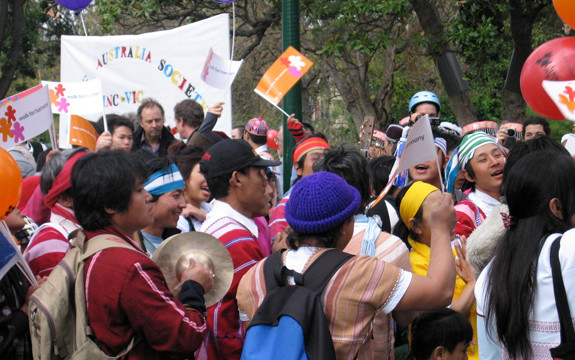Un-doing youth alienation: designs for belonging

In Summary
- Analysis for The Conversation by Elizabeth Dori Tunstall, Associate Professor, Design Anthropology, Swinburne University of Technology
“Could I have been Jihadi John?” asks British comedian and actor Russell Brand in a YouTube video first broadcast on March 3. In 10:32 minutes, Brand examines the underlying social conditions that are leading young Europeans, both of Muslim and non-Muslim faith, to join ISIS. Brand states:
The kernel of truth in the sprawling, bewildering bramble of ISIS madness is society isn’t working, the system isn’t working, it’s totally corrupt. That’s the thing that resonates with the core of young people. That’s the thing that pulls them into mad jihadism.
This also affects Australia. In October of last year, Australia reeled from the discovery of another Australian recruit, Abdulla Emir, in an ISIS propaganda video. Yet as the Point Magazine noted, he was one of an estimated 70 young Australians in Syria and Iraq.
British journalist, Kenan Malik raises the fundamental question in his recent the Observer piece, The Making of Wannabe Jihadis in the West:
Why is it that so many intelligent, resourceful, young people find an ideology that espouses mass beheadings, slave labour, and the denial of rights to women more appealing that anything else that is on offer?
Both Brand and Malik leave the question open. But UTS scholars Andrew Jakubowicz, Jock Collins, Carol Reid, and Wafa Chafic point to two main policy implications that address some of the underlying issues that cause Australian youth alienation, specially among minority youth.
The first is to give young people the opportunity to produce their own positive representations of themselves in the media to counter the negative images of youth in general, and specifically minority youth, in the media. The second is to reduce “the salience of ethnicity as a barrier to mobility and participation.”
Policy implications are important for scaling the impact of social changes. But as design anthropologist, I am interested in those who are making it happen.
Youth-led media and SNY
One of the best models for youth-led media is the Melbourne-based Student Youth Network (SYN). Started in 2000, the media organisation offers people 12-25 years of age media training in digital radio and television content creation and distribution.
SYN’s Meet the 2014 collective of 1700 daily producers.
I first heard about the organisation through the participation of the daughter of close friends, who is a member of the 2014 leadership team. The diversity of SYN’s leadership team is exciting. It means that SYN’s programming has the opportunity to reflect the diverse racial and ethnic strengths and challenges in the participants’ communities.
With 80,000 people tuning into the radio programs each week, SYN is reaching the youth. According to the organisation’s statistics:
Our target audience is 12-25 year olds … only 18% of all Melburnians fit in that grouping, yet 54% of the SYN audience are in that age bracket.
When young people feel as if they have a voice and as set of self-determined images, the feelings of alienation that drive them to associate with groups engaged with antisocial behaviours decrease.
The challenge, of course, is scaling the reach of organisations such as SYN.
Anti-discrimination

Anti racist rally in Sydney, Dec. 2005. Image credit: M.E./Wikimedia.
The prevention of discrimination based on ethnicity is enshrined in Australian Fair Work laws. Studies, such as the 2012 Vic Health CALD Experiences of Racism. Media reports show that in spite of these laws discrimination continues to impede the advancement of people from culturally and linguistically diverse groups, with negative effect on their social and emotional well-being.
Some interesting government-funded e-training programs that directly address the issues includes Queensland Council of Social Service’s Community Door course on working effectively with culturally diverse clients and co-workers.
A sense of belonging is crucial to people’s social and emotional well-being. One would be surprised by how small design gestures can affect a person’s sense of belonging.
As an African-American migrant to Australia, I evaluate my sense of belonging based on whether the photography shows people of different ethnicities and races. I have decided not to attend conferences because the website images did not have enough women and people of colour to represent a diverse event.
Although I speak American English, which is closely related to Australian English, I look for whether materials are translated into other languages. The simple reason is that it shows the organisation cares about good communication with people.
Of course, none of these small design gestures can work unless the systems underpinning them become fair and just to all peoples.
We now live with the consequences of not offering some youth a better ideology than one offered by organisations like ISIS. There are good efforts underway, by groups such as SYN.
We now need to reach not just more youth, but everyone with a better ideology based on fairness and equality. Let the struggle continue.
Written by Elizabeth Dori Tunstall, Swinburne University of Technology. This article was originally published on The Conversation. Read the original article.

